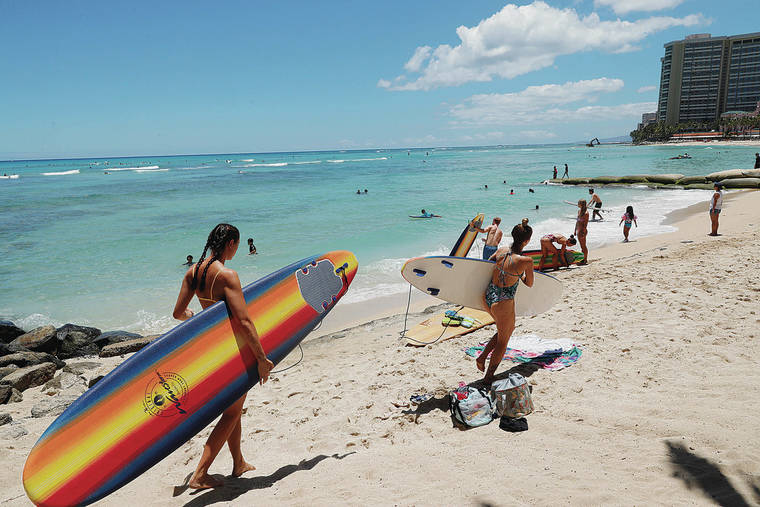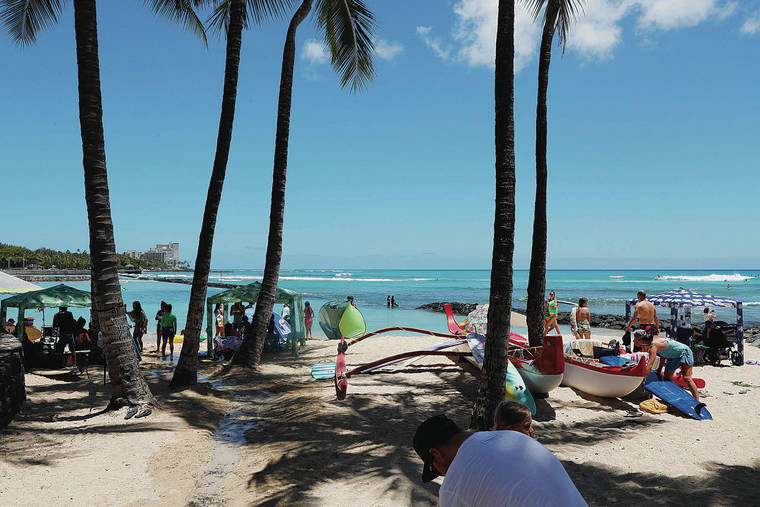Life returns to Waikiki, but not money, as Hawaii loosens COVID-19 restrictions

JAMM AQUINO / JAQUINO@STARADVERTISER.COM
Surfers carry their boards on the beach in Waikiki on Friday.

JAMM AQUINO / JAQUINO@STARADVERTISER.COM
Beachgoers and tents returned to the beach Friday in Waikiki. As the state’s number of coronavirus cases continues to teeter, many have taken to resuming outdoor activities, with minimal social distancing and disregarding safety protocols set forth to “flatten the curve.”


Save for the face masks and many business closures, Friday almost looked like a pre-COVID-19 day in Waikiki.
The state’s most famous beach was dotted with colorful umbrellas as residents and visitors caught rays and waves. Although most hotels in Hawaii’s top tourist district remained closed, trickles of customers were seen milling about the stores and restaurants that have reopened for limited business. A few pedestrians were walking on nearly every block. Some parents were even pushing baby carriages.
Still, it’s clear that tourism hasn’t yet begun to climb back up the cliff it fell off at the end of March.
Only 300 out-of-state visitors arrived in Hawaii on Thursday. The count was one of the higher daily visitor counts since March 26, when the state implemented a mandatory 14-day self-quarantine for passengers arriving on trans-Pacific flights. However, it was lower than May 23, the Saturday before the Memorial Day holiday, which brought a record of 384 visitors who were required to quarantine.
Average daily visitor counts have been higher this month than earlier in the quarantine, when most destinations around the world were still on tight COVID-19 Opens in a new tablockdowns Opens in a new tab.
The reopening of some destinations seems to have stimulated more interest in travel, and more demand for Hawaii is expected to materialize as more of the state reopens — but not at a level even close to what it was at this time last year.
Don't miss out on what's happening!
Stay in touch with breaking news, as it happens, conveniently in your email inbox. It's FREE!
“More people started to come back to Waikiki two weeks ago. They are at the beaches and out for walks,” said Mufi Hannemann, president and CEO of the Hawaii Lodging & Tourism Association. “But most of what they are doing is the free stuff that’s not going to stimulate our economy. The only store with lines is Ross Dress for Less.”
Sam Shenkus, vice president director of marketing for the Festival Companies, which manages Royal Hawaiian Center, said all of the center’s restaurants that offer carry-out are seeing steady business, mostly from Waikiki residents. There’s also been a recent uptick in construction workers and other workers who are trickling back in as more businesses are allowed to open.
“Waikiki is very slowly coming back,” she said. “We saw a real shift in traffic when Apple reopened on May 18 because it was something for the local market. Our luxury stores are seeing some local clientele return and wealthier second- and third-home owners. Tourism, of course, hasn’t returned.”
The tourism lockdown caused a 99.5% drop in visitor arrivals in April. Hawaii Tourism Authority reported Thursday that only 4,564 visitors traveled to Hawaii in April as compared to April 2019, when 856,250 visitors came by air and cruise ship. HTA did not provide a spending estimate for last month’s visitors, but it would have been minuscule compared to the $1.3 billion visitors to Hawaii spent in April 2019.
Ben Rafter, CEO of OLS Hotels & Resorts, said every month after will look about the same until Hawaii’s government leaders set a date to lift the quarantines.
Currently, the interisland and trans-Pacific quarantines are slated to run through June 30. Gov. David Ige has said he expects to lift the interisland quarantine soon but has indicated he plans to extend the trans- Pacific quarantine.
“We’ve got to find a way to safely move forward,” Rafter said. “Without tourism, many of the local businesses that reopen are still going to have shortfalls.”
Assuming the visitor industry will start opening in September, state economist Eugene Tian has forecast Hawaii will host 3.4 million visitors in 2020, a decrease of 67.5% from the 2019 level.
If that proves correct, it means that over the next eight months, only 1.3 million more visitors are expected to come to Hawaii. Tian has said it could take tourism here six years to recover.
Tina Yamaki, president of the Retail Merchants of Hawaii, said not all members will be able to take advantage of the lifted restrictions.
“Can retailers afford to open? That’s the No. 1 question. They’ve been closed now for two months. They’ve got lease rents that are due. They haven’t been able to pay taxes. They haven’t been able to pay utilities. They have had to let a lot of their employees go or be furloughed,” Yamaki said. “All this (personal protective) equipment that we need is costing money. If the money is not coming in and they are already owing a lot of money, it’s harder to justify.”
Travel is down all over, not just in Hawaii. However, 42% of 15,000 website users surveyed by rentcafe.com Opens in a new tab said they want to follow through with their vacation plans once it’s safe to travel. Those surveyed preferred beach getaways and road trips to city trips and traveling abroad.
Although Hawaii travel searches have taken a hit during the pandemic, Rentcafe’s survey said Hawaii took five spots on its list of Top 10 most resilient beach destinations.
With tourism lockdowns still in place, it’s not clear why any visitors would be traveling to Hawaii.
Those who came on Thursday certainly weren’t coming for vacation or business. Only 17, or 6%, of the 280 visitors who answered a state survey said they were coming to vacation. Even fewer people, 16 out of 280, said they were coming to Hawaii for business, a market that might be even harder to recover than the transient leisure market.
As many as 233, or 83%, of the 280 survey respondents said they were coming to visit friends and family. The remaining 14 left the question blank.
Thursday’s count also included 316 returning residents, 140 airline crew members, 114 military personnel, 68 people relocating to Hawaii and 54 transit passengers who were catching planes to other destinations. As many as 15 trans-Pacific flights arrived Thursday.



